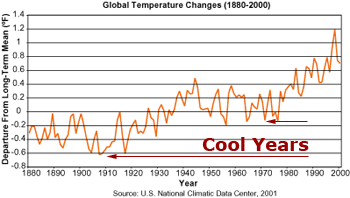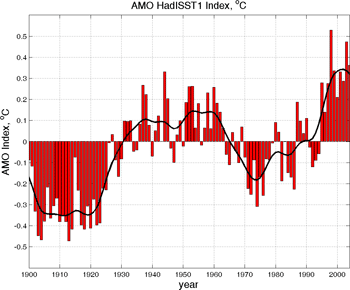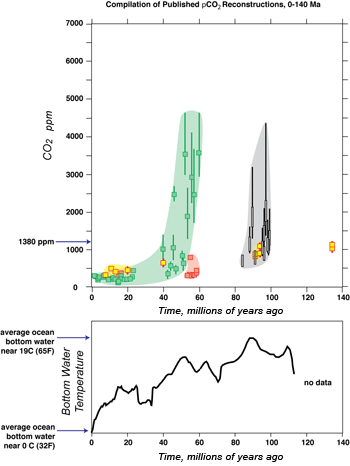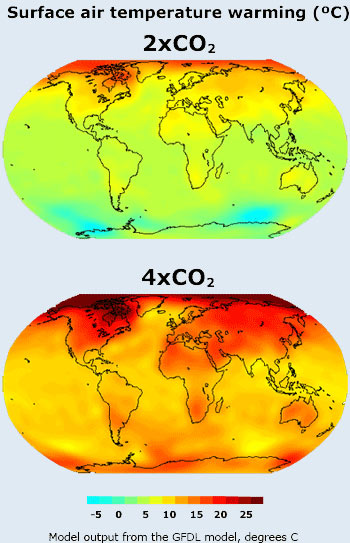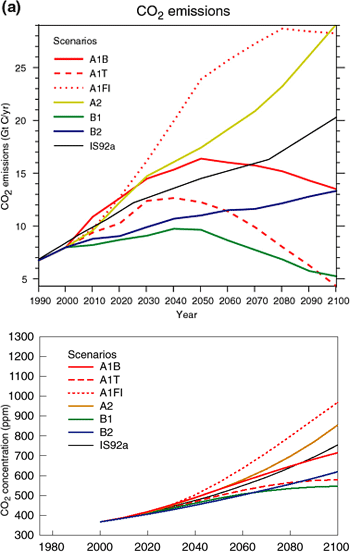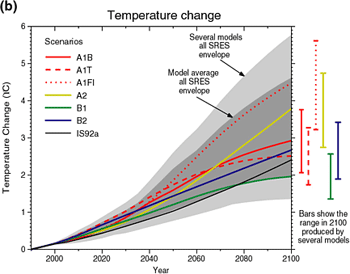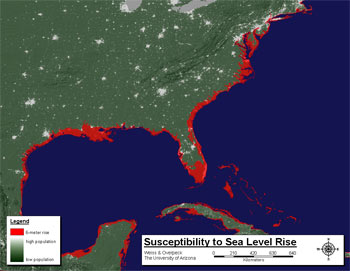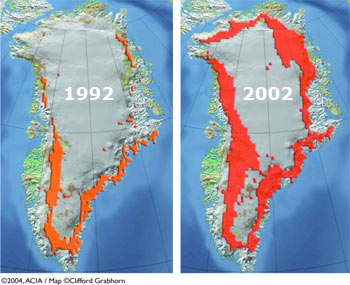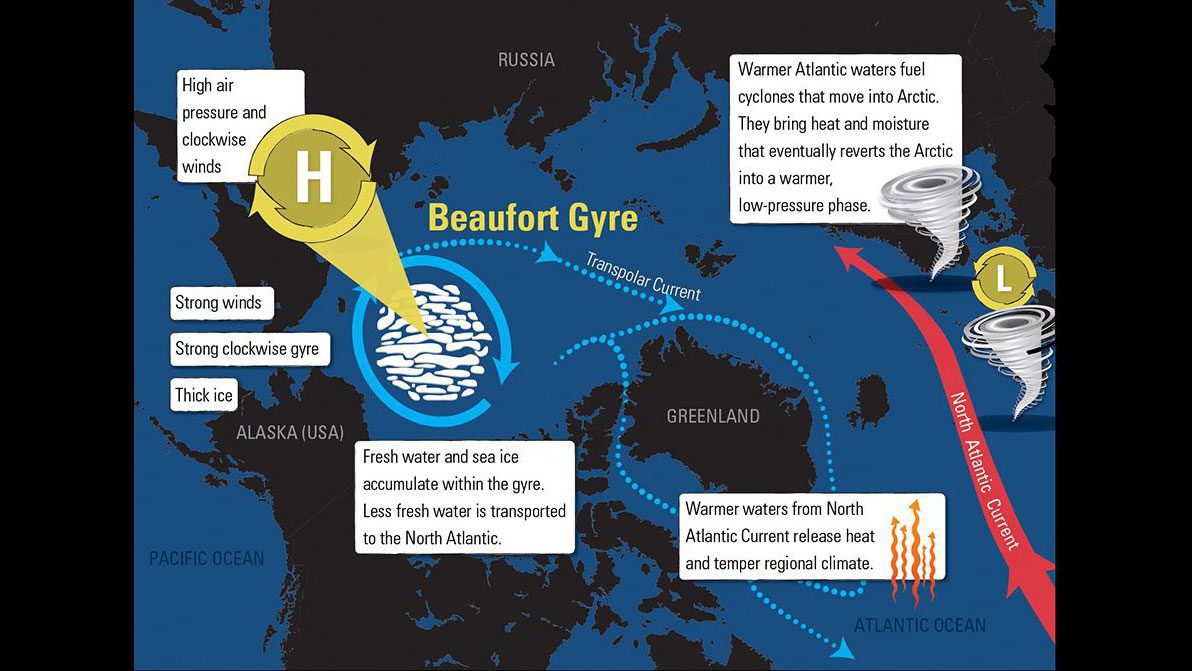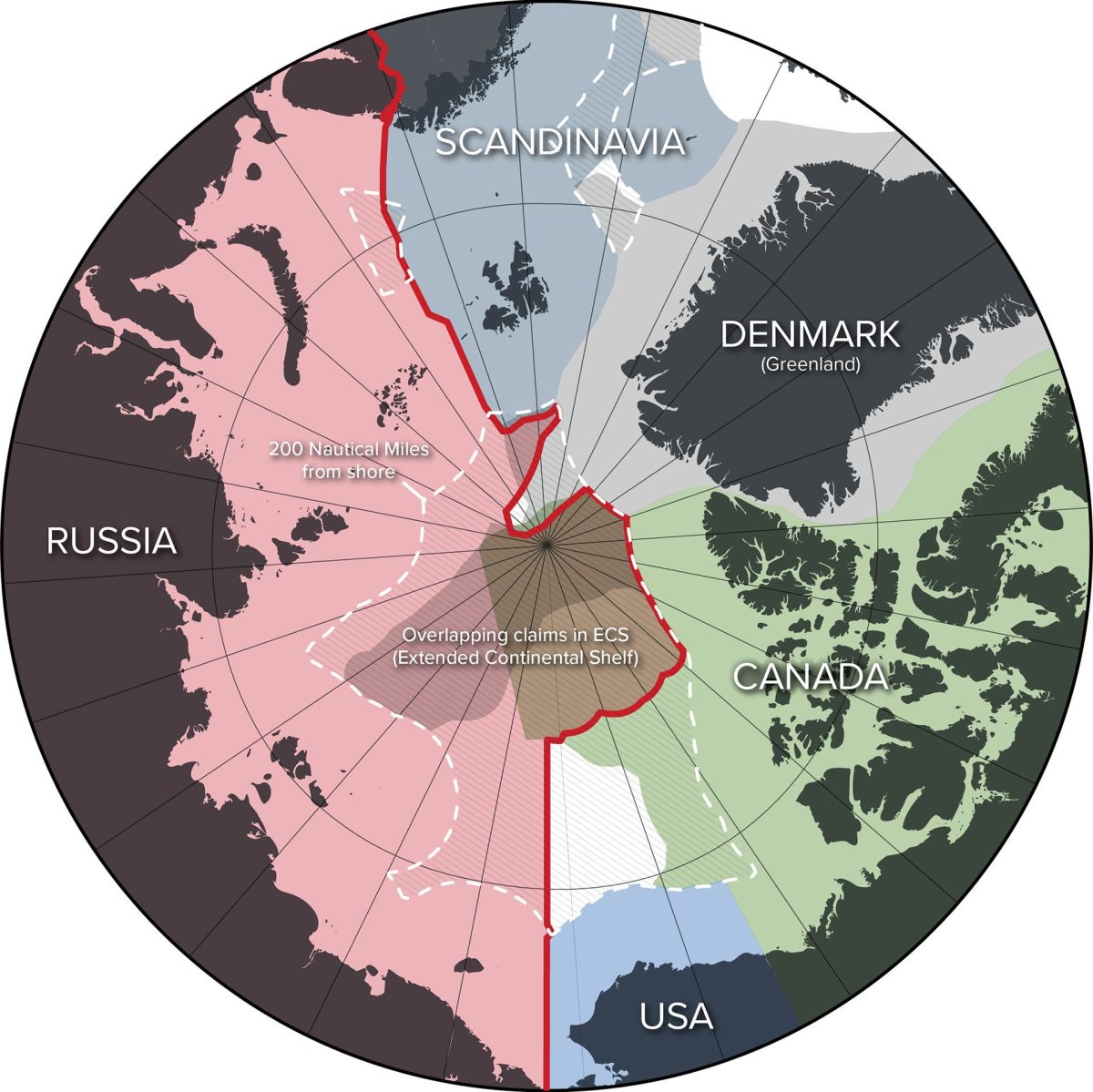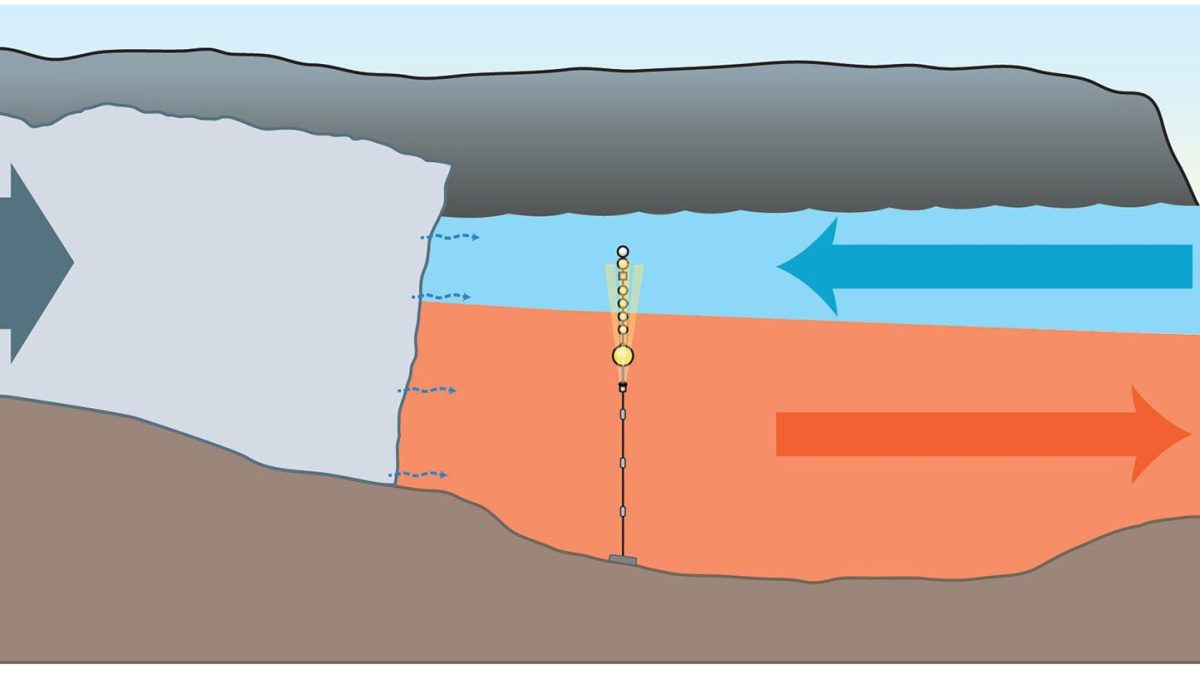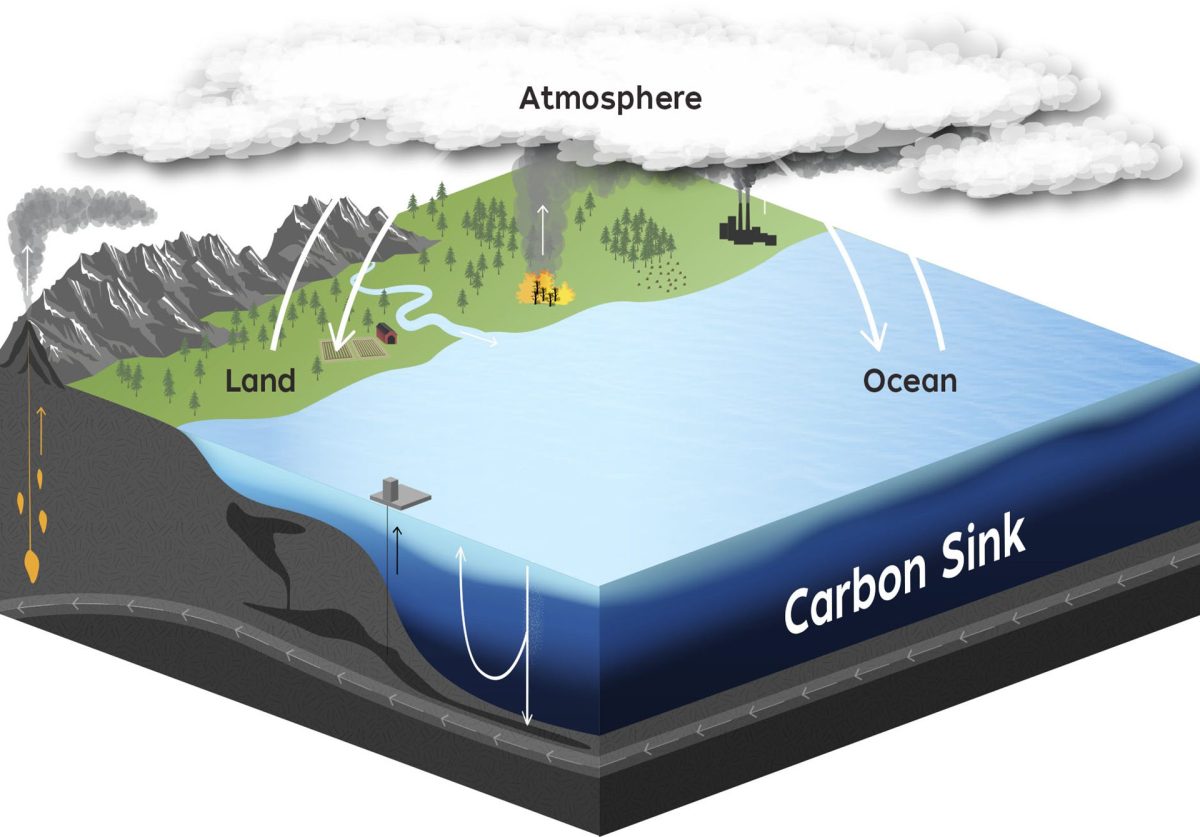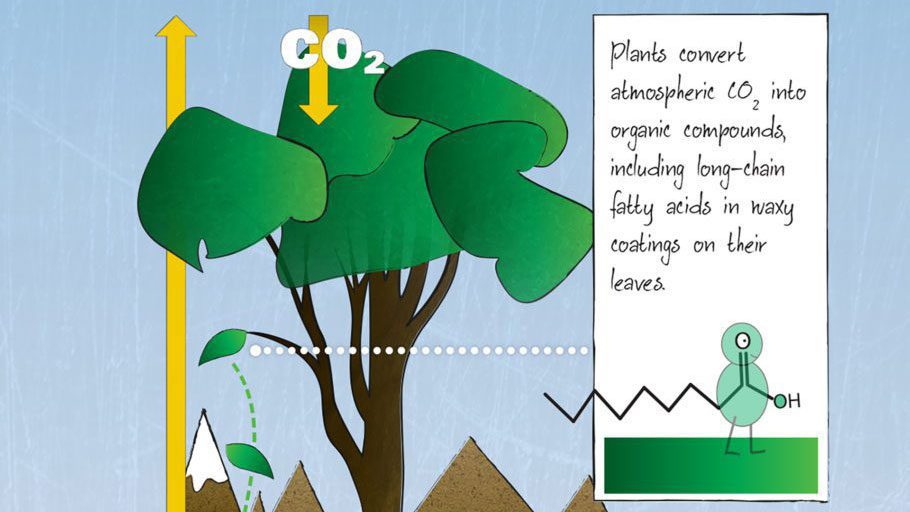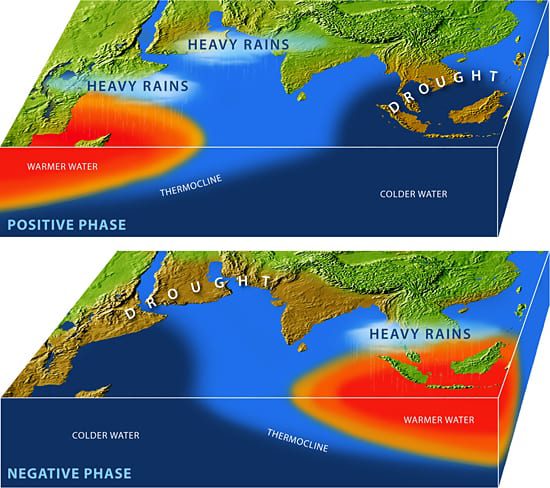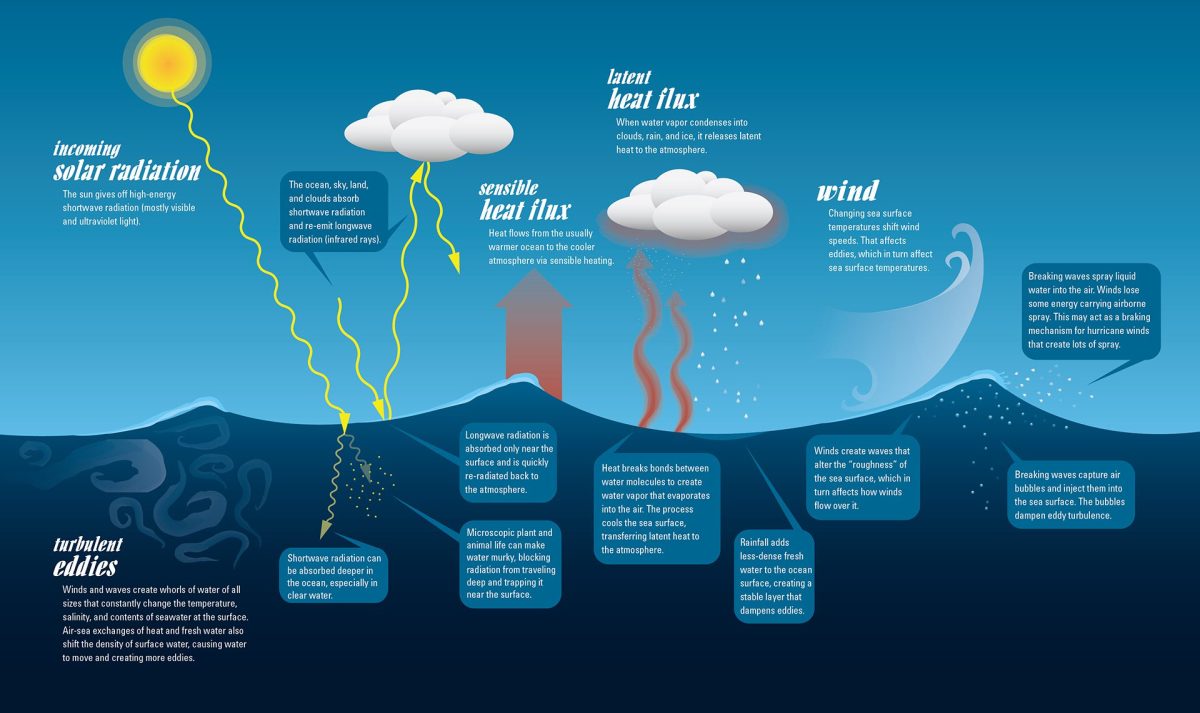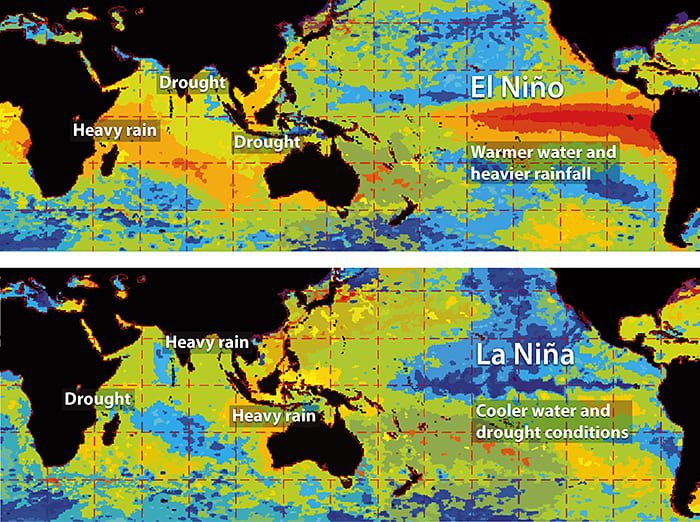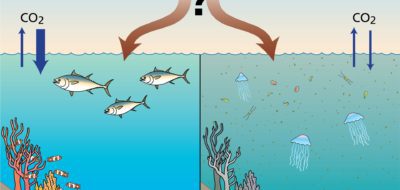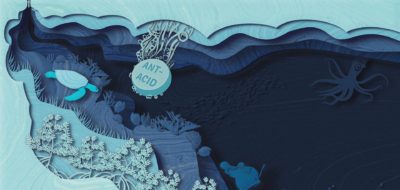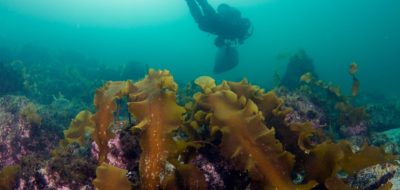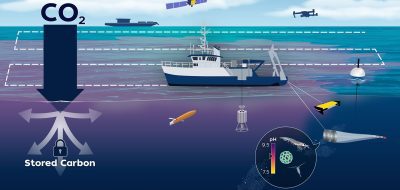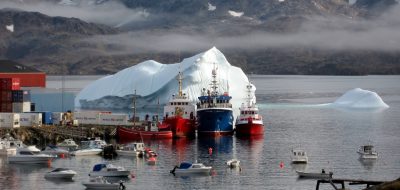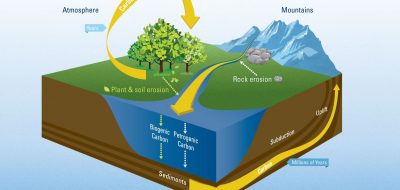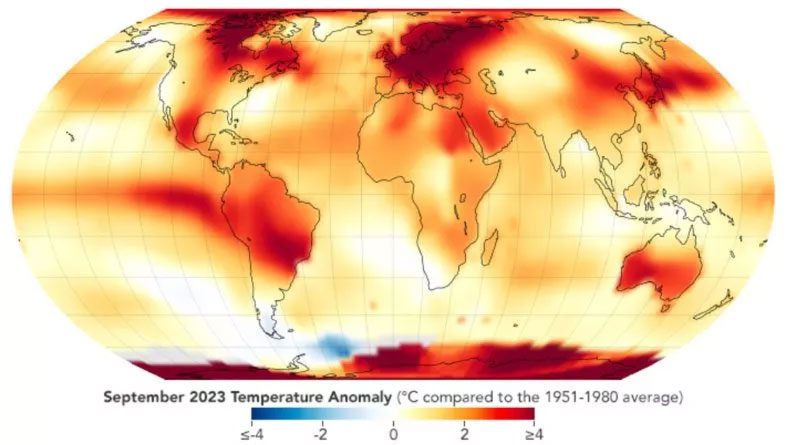
NASA map of global temperatures in September 2023. 2024 is on track to be even hotter than 2023, which was the hottest year on record. (NASA Earth Observatory map and charts by Michala Garrison, based on data from the NASA Goddard Institute for Space Studies)
Introduction
The following Q&A was developed from a panel discussion held in Woods Hole as part of the Institution’s spring trustee meeting, May 19, 2006. The discussion was introduced by Terry Joyce, director of the Ocean and Climate Change Institute and senior scientist, and moderated by Tom Wheeler, chairman of the corporation. Click here for brief biographies of the senior scientists who participated in this discussion.
- Is there is a warming trend?
- Does this warming trend account for all the hurricanes going on in the Atlantic?
- Is the recent increase in hurricanes due to global warming or part of a natural cycle?
- Why have atmospheric CO2 levels fluctuated over Earth’s history?
- What do you infer about the future from your studies of the Cretaceous Era?
- What are the climate models showing for a quadrupling of atmospheric CO2 in the future?
- How fast are these climate changes predicted to take place?
- I've heard that we are experiencing delayed climate effects today from carbon emissions that may go back as far as the beginning of the Industrial Revolution. Is there any truth in that, and if so, if humans changed their lifestyles now to reduce emissions, how responsive would the climate system be?
- I've read that the North Atlantic is becoming less salty. How is that affecting ocean circulation and climate?
- Are other gases, besides carbon dioxide, playing roles in climate change?
- If global warming takes place, what are the implications for the rise in sea levels in coastal areas?
- How much carbon dioxide is absorbed by the oceans?
- Do the increased amounts of carbon dioxide absorbed by the ocean affect marine life?
- Are all these changes really caused by human behavior, or natural causes, or a combination?
- Are you suggesting that there are no solutions and that basically, we’ve got to learn to live with these changes, and they’re going to get worse?
- How will global warming affect rainfall patterns?
Is there is a warming trend?
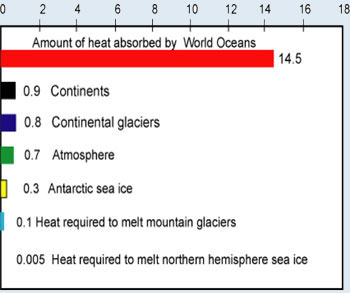
Comparison of heat absorption, 1022 joules
A. RUTH CURRY: Global warming is pretty well accepted by the scientific community. Because greenhouse gas concentrations are projected to continue rising throughout the next century, our expectations over the next 100 or 200 years are that we will continue to see an upward trend in temperatures.
The 1°C-per-century warming trend that’s often cited doesn’t really give the full story. That warming rate represents surface temperatures. Nearly all of the oceans show a greater rate of warming—1° to 2°C rise in the tropics and subtropics over the last 40 years.
Because we humans live in the atmosphere, that’s where we tend to perceive change. What’s actually happening is that the oceans and ice portions of Earth's climate system have been acting as a buffer to greenhouse warming: the oceans have absorbed 20 times more heat than the atmosphere (above right). Together, the oceans and ice have absorbed more than 10 times the amount of excess heat compared to the atmosphere plus land. This is effectively stemming the buildup of heat and carbon dioxide in the atmosphere.
Does this warming trend account for all the hurricanes going on in the Atlantic?
RUTH CURRY: Temperatures measurements show that the upper layers of the tropical oceans are getting warmer. Ocean heat is the fuel for hurricanes, but there are a number of other factors that also determine hurricane/typhoon activity. It is probably not the case that global warming will cause tremendously destructive hurricanes every year. But we will almost certainly see periods of time when all the factors that go into creating hurricanes—both atmospheric and oceanic—will align, and will result in destructive hurricanes—more so than if the ocean temperatures were cooler.
Is the recent increase in hurricanes due to global warming or part of a natural cycle?
A 100-year record of sea surface temperature change in the North Atlanic Ocean.
TERRY JOYCE: Both, and we have to understand that in addition to anthropogenic factors, there are natural factors that are significant. The record of sea surface temperatures in the North Atlantic shows two periods when temperatures were cooler: around 1910 and the mid-1970s (right). This is a natural oscillation, not associated with people. We think this is due to variability in the thermohaline circulation in the North Atlantic. There’s no direct evidence, but models indicate in that when the thermohaline circulation is strong, the North Atlantic is warm; when it’s weak, the North Atlantic is cool.
This is relevant to the Atlantic hurricane question, because if the North Atlantic is at a warm peak in its cycle, strong hurricanes are more likely. A recent study on hurricanes in the Atlantic found 30 years of increased hurricanes, and indeed over the last 30 years, Atlantic Ocean temperatures have gone up substantially. But the fact is, the largest number of Category 3 and 5 hurricanes wasn’t last year, but it was 1950. And if you look at where 1950 is on the Atlantic temperature record, it’s in the warm part of the cycle. So the fact is that global warming AND natural cycles are important for Atlantic hurricanes.
Q. Why have atmospheric CO2 levels fluctuated over Earth’s history?
KAREN BICE: In the absence of human influences, the amount of CO2 in Earth’s atmosphere is controlled by the balance between sources and sinks for CO2, much like the amount of money in your bank account is controlled by how much you put in and how much you take out.
The primary source for CO2 on geologic time scales is volcanism and outgassing from the mantle, deep within the Earth. Erosion of oil-rich, or petroleum-rich, rocks has also contributed to the amount of CO2 in the atmosphere in the past.
The sink for CO2, on geologic time scales, is the erosion of silicate rocks. Silicates are the type of rock that make up mountains. So the erosion of mountains reduces CO2 in the atmosphere; volcanism increases CO2 in the atmosphere.
If we go back to about 90 million years, to the mid-Cretaceous Period when the dinosaurs roamed the Earth, there is evidence from Cretaceous-age rocks that there was much more volcanic activity than there is today. We therefore would predict higher atmospheric CO2 then.
We also note that sea level was higher during this time period, and there was less exposure of silicate rocks, and therefore we predict lower rates of removal of CO2 through silicate weathering in the Cretaceous. Put those two together, and we would predict that CO2 was higher in the past, and what the data suggest, is that CO2 was, at a minimum, 500 parts per million (ppm); some estimates suggest thousands of ppm. So the mid-Cretaceous is one of the classic time periods that we look to understand what the future might look like.
What do you infer about the future from your studies of the Cretaceous Era?
If present CO2 levels (about 340 ppm) were quadrupled, CO2 levels would be within the range that prevailed during the Cretaceous, the age of the dinosaurs 90 to 100 million years ago (top). The high CO2 levels of that period (bottom) were associated with deep sea temperature around 19°C (65°F). Today deep sea temperature is around freezing.
KAREN BICE: The Intergovernmental Panel on Climate Change (IPPC) has periodically asked scientists to run their computer models (which simulate Earth’s climate dynamics) with a doubling of CO2, or about 680 ppm, and estimate what Earth’s climate would be like. The forthcoming IPCC has asked modelers to now look at a quadrupling of CO2, because panel members looked at the trends of emissions and the observed increase in CO2 in the atmosphere, and they don’t see it stopping at a doubling of CO2 before we’re done with what we’re doing to the atmosphere. A quadrupling of CO2, or 1,380 ppm, in the atmosphere resembles conditions in the mid-Cretaceous, 90 to 100 million years ago (Right, top).
I have run climate models with CO2 concentrations that we have inferred from fossil data for the Cretaceous and looked at the temperatures that the model produces. We’ve always had trouble getting these very same climate models that are used to predict future climate to simulate or reproduce the temperatures from past warm periods. If our past estimates of CO2 concentrations are correct, the climate models that we’re using to predict climate at 1,380 ppm CO2 are underestimating the amount of warming that the Earth experiences when CO2 is high, as it will likely be in the future.
When you ask what temperatures were in these past warm intervals, we estimate that water temperatures in the deep ocean were much warmer—close to 19°C (65°F), as opposed to 0°C (32°F) today. The tropics were warmer. The high latitudes were warmer. We don’t believe that there was sea ice in the Arctic Ocean, and very small if any ice sheets on Antarctica. So this gives us a potential picture of the future.
Q. What are the climate models showing for a quadrupling of atmospheric CO2 in the future?
More CO2 means a warmer atmosphere. Global mean air temperatures in some regions would be 15° to 20°F (8°C to 11°C) warmer if CO2 doubled (top), and 25°F (13°C) warmer if CO2 quadrupled (bottom).
PETER WINSOR: If you double today’s CO2 concentration (right, top), the models show that global mean air temperatures in some regions would be 15° to 20°F (8°C to 11°C) warmer than we have today.
It’s not a steady response globally. Much of the warming in a lot of these simulations actually happens at mid to high latitudes. That’s one reason why we’re interested in studying the Arctic, because we think we might see evidence of global warming there first, and the response would be larger there. And if you have a larger response it’s easier to actually deduce what’s natural and what’s human-induced.
If atmospheric CO2 quadruples (right, bottom), a recent simulation by the Geophysical Fluid Dynamics Laboratory show that things get extremely warm. It’s 25°F (13°C) warmer over much of the planet, including the Southern Ocean region.
How confident are you of the accuracy of the models?
PETER WINSOR: There are very large uncertainties in these model projections. They reproduce a lot of climate responses well, but they lack other important key processes. For example, they’re not very good with clouds and water vapor. They’re doing a so-so job with reproducing the present climate, so we—at least myself—have a hard time putting too much trust in what they show 100 years from now. But it does give you a hint of what the climate response might be in the future.
Q. How fast are these climate changes predicted to take place?
Graphs show several possible scenarios for how much carbon dioxide emissions people will produce in the future (top), how much CO2 will remain in the atmosphere (middle), and how much temperatres will rise as a result (bottom).
SCOTT DONEY: One of the problems of doing future climate projections is that there are actually three components involved, and you need to get all of them right in order to get the climate projection right. The first is: What are human beings are going to do? How much carbon dioxide are we going to burn? How are we going to change the land surface? What other gases are we going to release, and in what quantities?
The second is: Once you release those gases into the atmosphere, how much stays there? So, for example, a lot of the carbon dioxide that comes from burning fossil fuels ends up being taken up by plants or getting absorbed into the ocean.
The third is: What is the climate response to elevated carbon dioxide levels? Only after you have a good idea of what the CO2 increase in the atmosphere will be can you begin to figure out how much the climate will change.
So when people ask, “Well, what’s the future going to look like?” it’s hard to answer that question and make a confident prediction. Because we don’t know what human society’s going to do, we use several possible scenarios. These variations depend upon assumptions about how fast technology’s going to change, how quickly the world might get behind changing carbon emissions, and other political and social factors.
But when we factor in various scenarios of how humans are going to act, and then what will happen to the carbon dioxide we emit, and finally how sensitively the climate will respond to the various CO2 scenarios, we get a warming on the order of 6°F, plus or minus 2°F, within the next 80 to 90 years. So this isn’t something that’s hundreds of years out. We’re going to see substantial warming even by the middle of this century.
Q.I've heard that we are experiencing delayed climate effects today from carbon emissions that may go back as far as the beginning of the Industrial Revolution. Is there any truth in that, and if so, if humans changed their lifestyles now to reduce emissions, how responsive would the climate system be?
SCOTT DONEY: The question basically comes down to: How much are we paying for now what we’ve done in the past? Once you burn fossil fuels, about half the carbon dioxide emitted stays in the atmosphere. We’re very confident of that, based on long-term records of the atmosphere and also from measurements of gases bubbles trapped in glacial ice.
The CO2 stays in the atmosphere for hundreds of years. So anything we’ve burned in the past up to now is going to be with us for hundreds of years. Eventually, that catches up with us. Even if we were to cut off all CO2 emissions right now, the planet would still continue to warm. So, we do have a substantial commitment to climate change, no matter what we decide to do right now. And then the reality is, of course, it would be very difficult, with the global economy, to stop carbon emissions.
I've read that the North Atlantic is becoming less salty. How is that affecting ocean circulation and climate?
RUTH CURRY: If you put a lot of fresh water into the North Atlantic Ocean, it can actually slow the ocean circulation there and can lead to an abrupt shift in climate. We know from geological evidence that that has happened in the past.
Is that going to happen as a result of global warming? It’s possible, but I think probably not. The simplest reason is that a warming planet cannot support the growth of ice, and freezing the fresh water on the surface of the North Atlantic is probably necessary to initiate the sequence of events that changes the ocean circulation and grows ice sheets on land.
Ice is a white, reflective layer. The sun’s energy hits that light-reflective layer, and it’s radiated back into space. So if you grow a little bit of ice, you radiate more energy back into space, and you get cooling. Well, that causes more ice to grow, and so you go into a feedback loop that keeps forcing the climate to get colder and colder, which, in turn, creates more ice.
The opposite is what’s actually happening right now. Our sea ice is shrinking. As sea ice in the Arctic Ocean shrinks, less solar radiation is reflected back to space and more heat is absorbed by the oceans—that are now exposed because there is less sea ice.
So we’re going in the opposite direction right now. We’re absorbing heat. That melts more ice. That absorbs more heat. And that feedback loop is likely to dominate any other factor, such as freshening in the North Atlantic Ocean, and even a potential slowdown of the Atlantic circulation.
Are other gases, besides carbon dioxide, playing roles in climate change?
SCOTT DONEY: In addition to carbon dioxide, there are several other greenhouse gases that lead to warming: methane, nitrous oxide, and the chlorofluorocarbons that everyone’s heard so much about, which are associated with the ozone hole.
There are also compounds emitted to the atmosphere that can lead to net cooling. When we burn fossil fuels, we actually release sulfates that produce small sulfate particles or aerosols. You can think of these as very bright little particles in the atmosphere that actually reflect a lot of sunlight back to space.
One of the areas of considerable scientific debate concerns the balance between warming due to CO2, and cooling due to sulfates. The exact balance has not been that well quantified, and that’s one of the sensitivities of the climate models that we don’t know that well.
This may be significant because as a lot of countries start to reduce their sulfate emissions, which is associated with air pollution and acid rain, we may see sulfate aerosol levels in the atmosphere going down over time. The carbon dioxide emissions will go up, and we suddenly may see a dramatic jump in warming that’s been masked by this release of sulfate aerosols.
In the 1960s, before the Clean Air Act, there was much soot emitted, and there were also several volcanic explosions that also put aerosols into the atmosphere. The climate cooled a little bit, which may have caused by the addition of these aerosols. And actually that cooling may have masked the warming that would have gone on unchecked otherwise.
If global warming takes place, what are the implications for the rise in sea levels in coastal areas?
The red zone (top) denotes coastal areas flooded by a 20-foot (6-meter) rise in sea level. In Greenland (bottom) the area affected by seasonal ice melt (orange and red) has more than doubled in ten years.
TERRY JOYCE: Since the 1920s, global sea levels have risen about 6 inches (15 centimeters).
When the first IPCC report was issued, we estimated that roughly 90 percent of the sea-level rise was due to ocean warming—when water warms, it expands.
Now we think that only 40 percent of recent sea level rise has come from thermal expansion. The other 60 percent will be due to glacial ice that’s melted and gotten into the ocean.
What are projections? One of the things that we learned from the past is that when Earth’s climate was warmer, estimates are that sea level was 13 to 17 feet (4 to 5 meters) higher than it is right now, and that most of that sea-level rise was due to glacial ice, and most of that glacial ice was coming from Greenland, but a substantial amount was coming from Antarctica. And so we can expect that in the future.
Looking at a map of the eastern US with a sea level 6 meters above present levels indicates areas where future sea level rise will have consequences on coastal regions. It shows, of course, the flooding of south Florida, New Orleans (again), Washington DC, parts of New York City and even coastal Cape Cod (right, top). Other countries have more serious problems where island nations completely disappear, or large areas of low-lying coastal plains will be at risk. Of course, we don't know if 6 meters will occur in 100 or 1000 years. That we are headed for this scenario is likely given past interglacial sea levels and the added perturbation due to man's influence.
PETER WINSOR: We think we are seeing an acceleration of glacial ice coming to the ocean from Greenland (right, bottom in which orange and red depict the area of seasonal ice melt.) Scientists have become surprised by how fast this is going. The previous paradigm was that glaciers are thick and take a long time to melt, so we shouldn’t expect to see much glacial ice melting for a few hundred years.
But now the increasing evidence is that, as the glaciers start to melt, a lot of meltwater flows down to the base of the glacier, and thus lubricates the glacier, so they’re having an easier time moving out and calving glacial ice into the ocean.
Many scientists beleive that Greenland might be a big wild card for global climate change, but we know surprisingly little about the dynamics and response of glaciers. If you take the extreme case—which will probably not happen—and put all of Greenland’s ice in the ocean, you would increase global sea level by 23 feet (7 meters).
So, there’s a potential here for releasing glacier ice, and thus more fresh water, in the North Atlantic.
[Source: Impacts of a Warming Arctic: Arctic Climate Impact Assessment. Cambridge University Press, 2004. http://amap.no/acia/]How much carbon dioxide is absorbed by the oceans?
SCOTT DONEY: If we look back over the last, say, 150 years, our best estimates are that, for every pound of carbon dioxide we’ve emitted to the atmosphere, about a half a pound has gone into the ocean. And that’s based on both ocean surveys and ocean models, and also atmospheric data.
What’s going to happen into the future? It turns out the ocean carbon sink is quite sensitive to changes in climate. As we warm the ocean, warm water holds less gas than cold water. You can figure that out if you leave a can of soda pop out in the heat: When you open it up, the bubbles come out. That’s because a lot of carbon dioxide has come out of the soda and is sitting as a gas, right underneath the cap of the soda bottle.
Also, changes in ocean circulation are going to lead to a reduced ability of the ocean to take up carbon. But we don’t really understand the interactions of the ocean and atmosphere well enough to know how much CO2 will continue to be taken up by the oceans and how much will remain the atmosphere in the future.
Do the increased amounts of carbon dioxide absorbed by the ocean affect marine life?
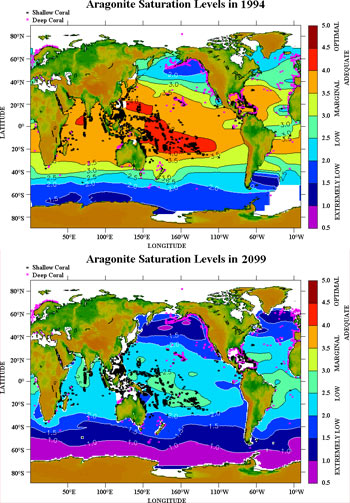
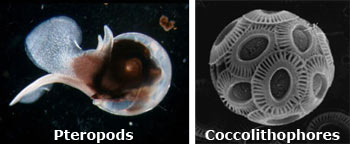
SCOTT DONEY: Carbon dioxide is a weak acid. When you dissolve carbon dioxide in water, you form carbonic acid.
Unfortunately, a lot of organisms in the ocean form shells out of calcium carbonate. You can think of chalk, and if you want to do an interesting experiment, put a piece of chalk in a jar with vinegar, which is a weak acid. You can watch the chalk dissolve and disappear. That’s what’s going to happen into the future as we continue to add carbon dioxide to the ocean. All the shells of these small, little marine organisms and of corals, which also form their shells out of calcium carbonate, are going to start to dissolve. In fact, there’s good evidence from the laboratory that a whole range of organisms are unable to form their shells in a high-CO2 environment.
The maps (at right) show a color-coded estimate of how easy it was in 1994 for marine organisms to form shells out of calcium carbonite. Red and orange indicate areas in the oceans where organisms can form shells easily. But in the projection for 2099, all the red and orange areas are gone, and you see blue and purple regions, which indicate areas where the chemistry of seawater has changed so that it is chemically impossible for organism to form their shells. This is true for everything from microscopic phytoplankton and zooplankton (coocolithpores) and small marine snails (pteropods) (bottom, right) that help form the base of the food chain in the Southern Ocean, up to tropical corals and deep-sea corals.
Based on what we know right now about ocean biology and its sensitivity to carbon dioxide, we’re going to be living in a very different world in terms of ocean life 100 years from now.
Are all these changes really caused by human behavior, or natural causes, or a combination?
RUTH CURRY: We have a pretty good idea of how CO2 has fluctuated in the atmosphere for the past 650,000 years. We have cores of glacial ice that have accumulated in Antarctica over 650,000 years, and they have trapped in them tiny bubbles from the atmosphere in the past. Scientists can figure out what atmospheric carbon-dioxide levels were in each year in the past.
Throughout that entire 650,000-year time span, the natural CO2fluctuation is 190 to 280 parts per million. Today we’re at 381 parts per million, and almost all of that extra 100 or so ppm increase has happened in the last 100 years—that is, since the Industrial Revolution. There’s not much doubt that the increase is due to anthropogenic burning of fossil fuels.
KAREN BICE: We are taking carbon from deep in the Earth and putting it into the atmosphere. Rather than allowing carbon-rich sediments to remain buried and be naturally exposed and eroded over the course of millions and tens of millions of years, we’re reaching down into the Earth, and we’re pulling those carbon-rich sediments and liquids and gases out of the geology of the Earth and putting them into the atmosphere.
That is why the CO2 we’ve put into the atmosphere is going to be with us for a while. Because if we want to return to a preindustrial-like atmosphere, it would take millions of years for that carbon to be put back where we got it. It’s going to require erosion of silicate rocks and the chemical reactions that go with that.
The only explanation for the increase in CO2 that we’ve observed in the past 100 years is that we are taking carbon out of rocks and putting it into the atmosphere.
Humans are doing that. Other animals aren’t doing that. Plants aren’t doing that. It’s humans drilling for and burning fossil fuel.
And at the same time, we also know that, through deforestation, we’re taking way one of the short-term sinks for CO2, which is forest growth.
Are you suggesting that there are no solutions and that basically, we've got to learn to live with these changes, and they're going to get worse?
KAREN BICE: These are changes we will have to live with. How dramatic future changes will be depends on what we continue to do, or what we stop doing. We can mitigate the amount of CO2that is going to eventually end up in the atmosphere through anthropogenic means by changing our behaviors.
SCOTT DONEY: There are pilot projects to help mitigate the problem. If you think about it, all hydrocarbons, whether coal, oil, or natural gas, have two components: carbon and hydrogen. The idea is you split the carbon and the hydrogen and store the carbon back in a geological reservoir. And in fact, in Norway, they are pumping CO2 back into the ocean. You then use the hydrogen to drive a hydrogen-fuel economy. So, when people talk about a hydrogen-fuel economy, that’s where they’re going to get the power source—from fossil fuels. The reason why it’s somewhat environmentally benign is you take carbon and sink it back into the well that you originally got the oil or the gas from, so it doesn’t get into the atmosphere.
How will global warming affect rainfall patterns?
TERRY JOYCE: The conventional idea is that if you warm up the atmosphere, it will hold more water vapor and increase the potential for more rainfall. That’s more or less true, but projections indicate that this is not going to be uniform everywhere.
We’re already seeing examples from Ruth Curry’s research that we’re getting more evaporation—and less rainfall—in subtropical areas. We’re getting more water at high latitudes, falling as rain and snow.
Civilizations in the past have not failed because temperatures go up or down 1° degree Celcius. But civilizations have failed because rainfall has changed, for example from 11 inches a year to 10 (28 centimeters to 25 centimeters). At that point, you’re in a desert, and in fact, there are projections for very large changes in precipitation in the future in large areas in the U.S. Southwest and large areas of southern Europe. Not only less rain, but also less snowfall. These regions may be very dry, looking ahead in the future. Sea-level changes may affect people in Cape Cod more than those who live in Colorado, but changes in precipitation patterns could change what those people can or can’t grow and have large impacts far from the coast.
Panelists

Terry Joyce is director of the Ocean and Climate Change Institute, and a senior scientist in the Physical Oceanography department. Terry’s research interests include oceanic mixing phenomena, Gulf Stream dynamics, decadal and longer-term climate variability in the ocean, and the physics of ocean circulation.

Karen Bice is an associate scientist in the Geology and Geophysics department. Her areas of interest include the role of ocean circulation in climate change for the last 570 million years, and reconstruction of paleoclimates using numerical models.

Ruth Curry is a research specialist in the Physical Oceanography department. Her research focuses on how changes in the world's ocean circulation and water mass properties influences the global climate system. An area of interest is global freshwater distributions and the response of North Atlantic overturning circulation to greenhouse warming.

Scott Doney is a senior scientist in the Marine Chemistry and Geochemistry department. His research is on marine biogeochemistry and ecosystem dynamics, large-scale ocean circulation and tracers, air-sea gas exchange and the global carbon cycle. A particular area of interest is the dynamics of ocean acidification as it relates to increasing oceanic carbon dioxide.

Peter Winsor is an assistant scientist in the Physical Oceanography department. His areas of research include dynamics of ice covered seas, shelf-basin interactions, numerical modeling, sea ice thickness, and the physics of ocean mixing in polar waters.

